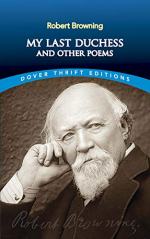|
This section contains 378 words (approx. 1 page at 400 words per page) |

|
My Last Duchess (Poem) Summary & Study Guide Description
My Last Duchess (Poem) Summary & Study Guide includes comprehensive information and analysis to help you understand the book. This study guide contains the following sections:
This detailed literature summary also contains Quotes and a Free Quiz on My Last Duchess (Poem) by Robert Browning.
The following version of this poem was used to create this guide: Browning, Robert. “My Last Duchess .” Poetry Foundation Online. https://www.poetryfoundation.org/poems/43768/my-last-duchess.
Note that all parenthetical citations within the guide refer to the line number in which the quotation appears.
"My Last Duchess" by Robert Browning was first published in 1842. Browning's father was a clerk and literary collector, his mother a talented musician, and he was raised to value reading and the arts. He was educated at home, where he showed early gifts in languages. He refused formal schooling or the pursuit of a career, preferring to focus on his poetry. At first, he saw immense success with longer works like Pauline, but he always struggled with insecurity. After initial successes, his career began to languish. He married fellow poet Elizabeth Barrett Browning and continued to write. During this time, he authored "My Last Duchess."
The poem initially appeared in Browning's collection Dramatic Lyrics, which he self-published during this low point in his career. It was not widely read at the time, although now it is considered one of his most celebrated works. Browning initially titled the poem "Italy," indicating its connection to the Italian Renaissance in both setting and theme. The poem is preceded by an epigraph, titled "Ferrera," which indicates the poem's connection to a particular incident in Renaissance Italy.
In 1558, the 25-year-old Fifth Duke of Ferrera, Alfonso II d'Este, married 14-year-old Lucrezia di Cosimo de Medici. The young bride remained in Florence, where she wrote letters to her husband, who did not respond and effectively abandoned her for two years. When she was finally brought to Ferrera, she was already sickly, and soon after died – likely from tuberculosis. However, there were persistent rumors that her husband had poisoned her. The Duke remarried soon afterwards.
The poem recounts this narrative almost exactly. In the poem, the unnamed narrator is looking at a portrait of his "last duchess" as he speaks to the servant of a count. He explores the beauty of the portrait and of the deceased duchess. However, he also accuses her of being flirtatious and disrespecting his station. He implies that he did poison her, and then attempts to arrange a marriage with the count's daughter.
Read more from the Study Guide
|
This section contains 378 words (approx. 1 page at 400 words per page) |

|



